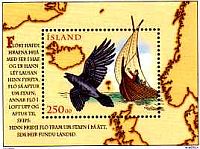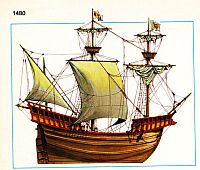
Stamp commemorating Floki and his ravens
The crows nest, as a shelter for the lookout on whaling ships sailing the icy waters of the Arctic, was by all indications, invented by Captain William Scoresby around 1807. (See yesterday’s post: Crow’s Nests : Part 1 — Melville & Captain Scoresby.) Nevertheless, many claim that the crow’s nest dates back much further. According to the “Origins of Naval Terminology” page on the America’s Navy website, the crow’s nest can be traced back to the Vikings. Their entry “crow’s nest” reads:
The raven, or crow, was an essential part of the Vikings’ navigation equipment. These land-lubbing birds were carried on aboard to help the ship’s navigator determine where the closest land lay when weather prevented sighting the shore. In cases of poor visibility, a crow was released and the navigator plotted a course corresponding to the bird’s flight path because the crow invariably headed towards land.
The Norsemen carried the birds in a cage secured to the top of the mast. Later on, as ships grew and the lookout stood his watch in a tub located high on the main mast, the name “crow’s nest” was given to this tub. While today’s Navy still uses lookouts in addition to radars, etc., the crow’s nest is a thing of the past.
This particular tale seems to be based on the saga of Flóki Vilgerðarson, who was the first Viking to intentionally sail to Iceland. He used three raven to help navigate. In the saga, Flóki set one raven free a few days after sailing from the Faeroe Islands. That raven flew back to the islands from whence they had sailed. Sometime later, Flóki released the second raven, which flew in circles and then returned to the longship. Some days later, Flóki released the third raven, which flew off in the direction of the closest shore, which by this time was Iceland. Flóki set a course to follow the raven and safely made it to Iceland. He was given the nickname, Hrafna-Flóki, Raven-Flóki. (Floki has recently turned up on cable television as an eccentric mystic played by Gustaf Skarsgård on the History Channel’s series, The Vikings.)
The account, believed to date from around the 9th century, is in some respects similar to the story of Noah’s ark, where Noah releases a raven and a dove. In the earlier epic of Gilgamesh, after Utnapishtim’s ark lodges on a rock, he releases a dove, a swallow, and a raven, in that order. So, whether ravens, or their near cousins, crows, were ever commonly used as navigational aids by the Vikings, or anyone else, is unclear, but it is at least possible. And it certainly makes for a good story.
What doesn’t make any sense, however, is the second half of the tale. There is no evidence that Norsemen stood watch “in a tub” at the masthead. Even if they did, which is highly unlikely, why would anyone carry ravens or crows at the masthead rather than on deck? Carrying birds at the top of the mast seems like an excellent way to end up with dead birds, which are definitely not effective for navigation. This account seems like a valiant attempt to adapt the story to the desired ending rather than anything based on history or even common sense.
So, where did the name “crow’s nest” come from? Captain Scoresby’s design was basically a wooden barrel covered either in leather or canvas. The canvas is likely to have been tarred to make it waterproof. The crow’s nest probably looked black against the sky, not unlike a bird’s nest high in a tree. Why not associate this lofty perch with a large black bird? It is also possible that the makeshift canvas shelters made by whaling lookouts could have been referred to as a bird’s nest, even prior to Scoreby’s innovation. Birds build their nests from whatever they have on hand, which was what the sailors were doing in the frigid Greenland waters. Why a crow? Why not? The crow’s call is harsh and loud, not unlike that of the lookout on a whaling ship.
One more question about crow’s nests come to mind. Around the 15th century ships began sprouting what looked to be structures very similar to crow’s nests. Where they indeed crow’s nests, or if not, what were they? Many historians refer to where ever the lookout was stationed as the “crow’s nest.” There are numerous modern references, for example, to Rodrigo de Triana sighting land from the “crow’s nest” of the Pinta, while there is no such reference to a crow’s nest or anything like it in Columbus’ journal.
I would argue that the basket shaped structures just above the main and fore yards on the carrack from 1480, to the left, are the beginnings of what we would know as the main and fore top on eighteenth and nineteenth century sailing ships. They do not appear on earlier ships with only a lower mast, like the Hansa cog, but are common on ships with compound masts, setting a top mast over the lower mast.
The top is a structure on a sailing ship located at the top of the lower mast, designed to support the shrouds of the top mast. Shrouds running to the top give better support than if they were run straight down to the ship’s side.
Beyond its main function of keeping the top masts aloft, the top was also a useful platform to fight from. Marines with muskets, rifles or even small cannon could fire down on enemy ships. Horatio Nelson was killed at the Battle of Trafalgar by a sniper firing from a fighting top of the Redoutable.
I suspect the basket shape of the 15th century tops was meant to provide cover for archers firing down on attacking ships. Just as the raised forward and after decks of a carrack were designed as fighting platforms, literally the fore-castle and after-castle, so it seems likely that the shape of the tops were also meant for ship defense.
In the 17th century, the tops on ships lost their basket shape but were still generally round platforms. In the 18th century, they became more trapezoidal. As ships carried t’gallant masts above the top masts and later even occasionally, royal masts, the ship “tops” kept getting proportionally closer to the deck as the mastheads grew loftier. By the 18th century, the main top was only about a quarter of the way up the mast and the lookouts stood watch on the cross trees or higher, usually without the benefit of a crow’s nest.


I believe that you will find that Nelson was killed by a splinter knocked off by a cannon ball.
For what its worth, I have sailed as Captain of a US merchant vessel in the foreign trade.
Hey Ross,
I think the eye-witness reports from the time say that Nelson was killed by a musket ball. The ball is apparently now on display at Windsor Castle.
THE MUSKET BALL THAT KILLED LORD NELSON
Why did the name ravens nest not catch on in England?